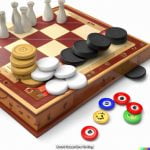Introduction
The Shakespeare Board Game is an engaging, exciting game that celebrates the work of one of the world’s greatest playwrights. Players must compete against each other to be the first to reach “The Globe Theatre” at the end of the board.
The game is played by up to 6 players, who will take turns rolling a die and moving around an intricately designed board shaped like William Shakespeare’s hometown in Stratford-on-Avon. As the players move around and traverse through different theatre locations along the board, they are challenged with questions related to The Bard’s plays and sonnets. Then, they must answer a series of riddles by finding their answers within some of his works. If they correctly answer all three, they win a spot on the stage at “The Globe Theatre!” In addition to answering some questions related to Shakespeare’s work, players also have opportunities throughout the game to collect cards drawn from a deck that contains anecdotes about his life and career.
Common terms used in this game include “Quote Cards”, “Stage Locations”, and “Destination Cards”. Quote Cards are cards which contain quotes from different plays written by Shakespeare. Stage Locations describe spots on the board where players have to complete certain challenges or tasks before being allowed to continue on their journey towards The Globe Theater. Finally Destination Cards are cards that you must get your hands on in order for you to reach The Globe Theatre at the end of the board. These cards help advance your progress as well as hinder your opponents’. It’s all part of a high-stakes race between you and your opponents!
Unboxing and Setting Up the Game
1. Unpack the game box: Open up the Shakespeare Board Game box and make sure that all the components – including the game board, six playing pieces, 20 Story cards, 30 Quote cards, 30 Character cards – are present and in good condition.
2. Place the game board flat on a table: Spread out the game board and make sure that each of its four parts is properly connected to create a large board with 4 sections.
3. Choose your player pieces: Each player may choose their playing piece (such as a dice, coin or pawn), which they will move around the game board in order to collect points depending on their answers to quiz questions.
4. Divide story, quote and character cards into piles: Once each player has chosen a playing piece, divide the Story Cards, Quote Cards and Character Cards into three separate piles to be used for different challenges during play.
5. Set rules for scoring points: Agree on how many points players can receive for correct answers to challenge questions; usually one point per answer is best suited for quick play.
6. Play!: In order to start play each person rolls the dice or flips coin ” highest roll goes first; make sure everyone has access to all piles of quiz cards in order to participate accordingly by asking/answering questions based on them!
Overview of the Gameplay Rules
Shakespeare board game is a multiplayer strategy game centered around Elizabethan England. Players move their pieces around a map of Britain, encountering characters from the Bard’s plays. The goal is to reach one of William Shakespeare’s major works from his First Folio, which contains 36 plays in total, while collect tokens along the way and achieving fame points.
The board itself is made up of eight regions surrounding six letter and four storage spaces. The letter spaces have names such as “Virtue”, “Love”, and “Archive”. The storage spaces feature icons representing weapons, literature, coins etc.
When players roll the dice they can choose to either move to an adjacent region or take an action like collecting money or meeting a character from a play. Additionally, encounters with character spaces allow players to gain Fame Points and artifacts like coins or weapons that in turn affect wealth points counteracted later by players who go bankrupt. The aim of the game is for each player to collect enough tokens for completing one or two plays depending on levels of difficulty before other players are able to do it first and increase their fame points higher than theirs. With every round becoming more intense as players race towards the end point of Finishing Line space where the play which has been completed contributes 3 bonus Fame Points per player side who completes it in time first!
How to Win the Game
The Shakespeare Board Game is an exciting game that pits two players against one another in an effort to answer trivia questions about the works of Shakespeare. The player to correctly answer the most questions in the shortest amount of time wins. To maximize your success, it is important to have a good knowledge of Shakespeare’s works. It also helps to know some good strategies and tactics for playing the game. Here are a few tips on how to win the Shakespeare Board Game:
1. Read up on specific plays: While having general knowledge of several Shakespeare plays is helpful, having a more detailed understanding of certain specific plays will give you an edge over other players if a question comes up about it ” so study what you can in advance. Make sure you understand plot points as well as common characters, words, and phrases from each play so you can answer questions quickly and accurately.
2. Have a backup plan: In case you don’t know an answer, it is important to have a back-up strategy for guessing their potency correctly. Make sure to familiarize yourself with typical Shakespeare themes and characteristics; this will help even if you don’t remember a direct quote or line from the bard’s works. Additionally, his use of poetic language also provides clues that might be useful when trying to guess out of context quotes or lines.
3. Know your timeline: Although dates associated with certain works may not necessarily come up in the game’s trivia questions, they offer invaluable insight into occurrent events happening while he was writing which can inform your understanding of those particular works; try studying up on major historical events that could’ve affected him or his works too!
4. Keep track of questions asked: In each round usually two separate sets of questions will come up for every player, however it may also be wise focus particular attention on ones previously answered by other players because one might just come up again during your turn; being able to recall what was previously asked and answered is key!
By following these tips and doing some basic preparation ahead of time, any player should be able to boost their chances of winning at the Shakespeare Board Game immensely!
Top Tips for Mastering Shakespeare Board Game
Tip 1: Familiarize Yourself with the Rules: Before you start playing Shakespeare Board Game, take some time to familiarize yourself with its specific rules. Through this knowledge, you will be able to understand how each card and component interacts with one another and create strategies to attack opponents in the game.
Tip 2: Think Before You Act: As in any game, it is important to think ahead before taking your turn. Analyze what cards are on the table and decide which moves are most efficient according to how they interact with your current situation. Knowing when it is an ideal time to play certain cards and pieces is heavily beneficial as this strategy can help to power up other pieces in a speedy manner.
Tip 3: Position Matters: Like chess, there is an important element of positioning in Shakespeare Board Game that needs consideration when making moves within the game. Take the time before each move you make to plan out not only the consequences of your action but also how this impacts any upcoming moves you have available ” constantly thinking about future options helps obviously define helpful tactics for gameplay!
Tip 4: Take Action When You Need To: Even with carefully thought-out plans, every now and then it’s necessary for players to take risks if all odds are starting against them. Exploit weak spots on the board, pressurise opposing players into making hasty decisions or even block off avenues of opportunity from opponents – being opportunistic and decisive at times during gameplay brings significant benefits when strategic points become revealed at critical moments; particularly towards the endgame!
The Different Parts of the Game
Shakespeare Board Game is a two-player strategy game played with a set of cards and pieces, each representing characters from the works of William Shakespeare. Each player starts with 50 points, representing the number of followers they have within their court.
The main components of the game are the cards and pieces. The character cards represent influential people from Shakespeare’s plays such as Hamletand Romeo and Julietas well as generic characters like fools or knights. These cards give players certain abilities when used in play, depending on what kind of card it is. For example, some cards may allow a player to draw more cards or give them access to previously blocked areas of the board.
The pieces contain information specific to that character like where they can move on the board or what actions they can take; they also represent how much influence they have over other characters. Players then use their pieces to help them gain control over certain spaces on the board, such as resource-rich provinces or powerful cities. The goal is usually to get more points than your opponent by controlling these locations and by using powerful strategic maneuvres made possible through belonging to either faction: Royalists or Familists.
By playing this game, players get an understanding of literary concepts such as context clues, symbols, and allusions while learning about and practicing strategy concepts such as planning ahead for multiple turns in advance and tactical movement of their pieces to control key locations on the board. Additionally, players can use different combinations of character cards for different scenarios which further develops their sense for effective decision making in complex scenarios!
Fun Strategies for Playing the Game
Shakespeare Board Game is a great way to explore the works of William Shakespeare while having fun with friends and family. Players must collaborate to build a play by choosing different characters, scenery, significant quotes and plot points. It’s also important to strategically trade with other players to acquire the best parts for their own performance.
To make their performance the best it can be, there are some tips and strategies for improving play and enjoyment level. The first tip is to plan ahead by keeping in mind what kind of play you would like to create. Would you prefer something comedic or tragic? Whichever you decide on will help guide your decisions throughout the game. Secondly, don’t be afraid to make offers when trading with fellow players; even if they don’t decide to accept it, negotiating may still net you extra cards that could help improve your play! Thirdly, acknowledge when other players have good ideas during the building process and embrace them in your own plays ” teamwork makes the dream work! Finally, don’t forget that each person takes turns performing snippets from their play at the end – so work hard on creating an amazing ending scene! With these tips in mind, everyone can have an enjoyable time while exploring William Shakespeare’s works together!
Conclusion
Playing the Shakespeare Board Game is a great way to learn and explore the life, literature, and vocabulary of the renowned Elizabethan playwright. Not only does it promote creative thinking and intelligence through its challenging puzzles, but it also entertains players with characters from Shakespeare’s plays. The game can also serve as an educational tool for students who look to understand his works in greater depth, as it draws on elements of Shakespeare’s legacy that were important during his time. It helps develop an understanding of the language used in his writing and serves as an entertaining reminder of the brilliance of one of history’s greatest writers. At the same time, players will benefit from insights into historical figures introduced throughout the game like Queen Elizabeth I or William Cecil, Lord Burghley. Furthermore, with its artistic elements based on dramatic illustrations inspired by beautiful stained glass art installations at Oxford University’s Clarendon Building, visually absorbing environments help make each game a unique experience filled with fun and creativity. Ultimately this board game provides both educational and entertaining benefits for those who take part in it.

I love playing all kinds of games – from classics like Monopoly to modern favourites like Ticket to Ride.
I created this blog as a way to share my love of board games with others, and provide information on the latest releases and news in the industry.





